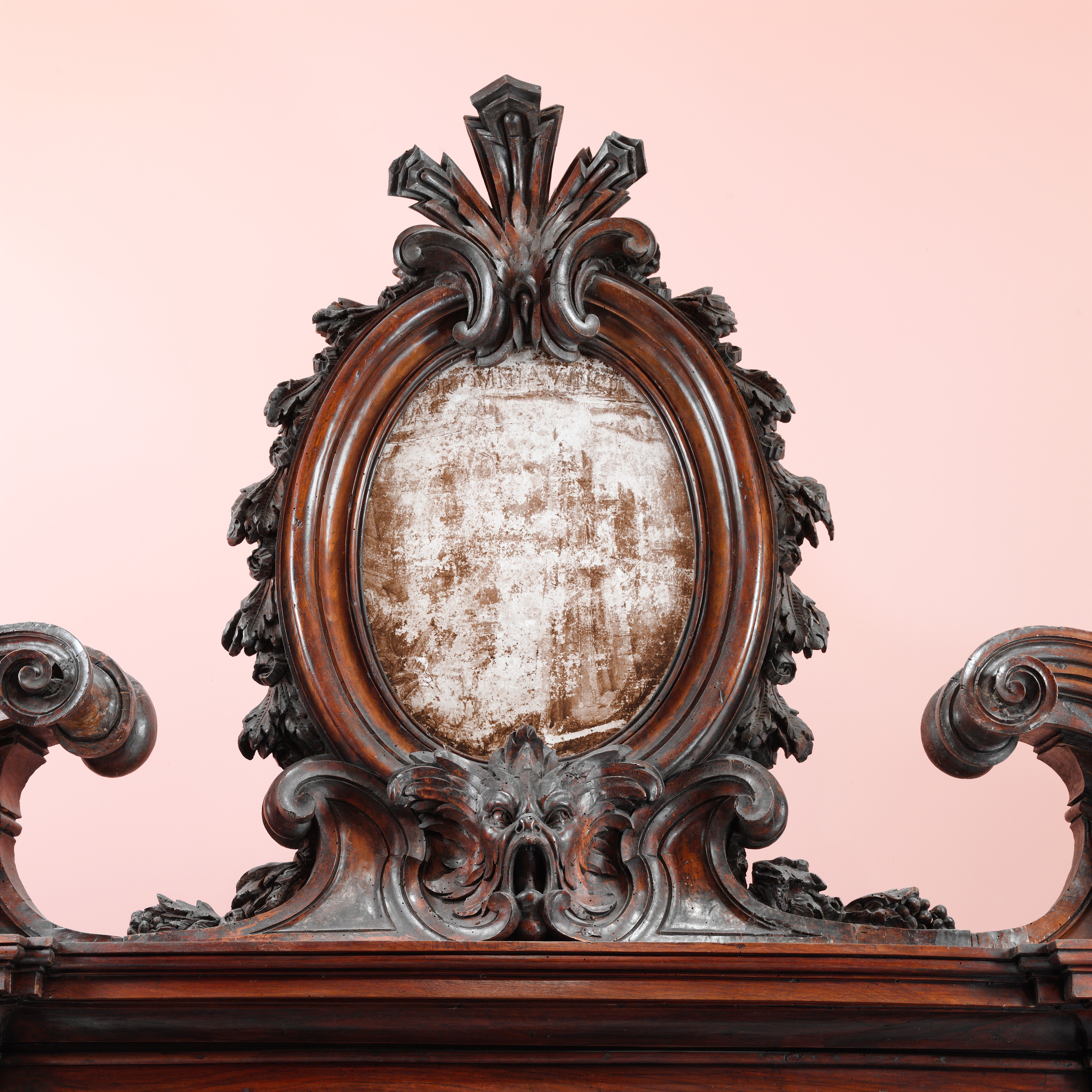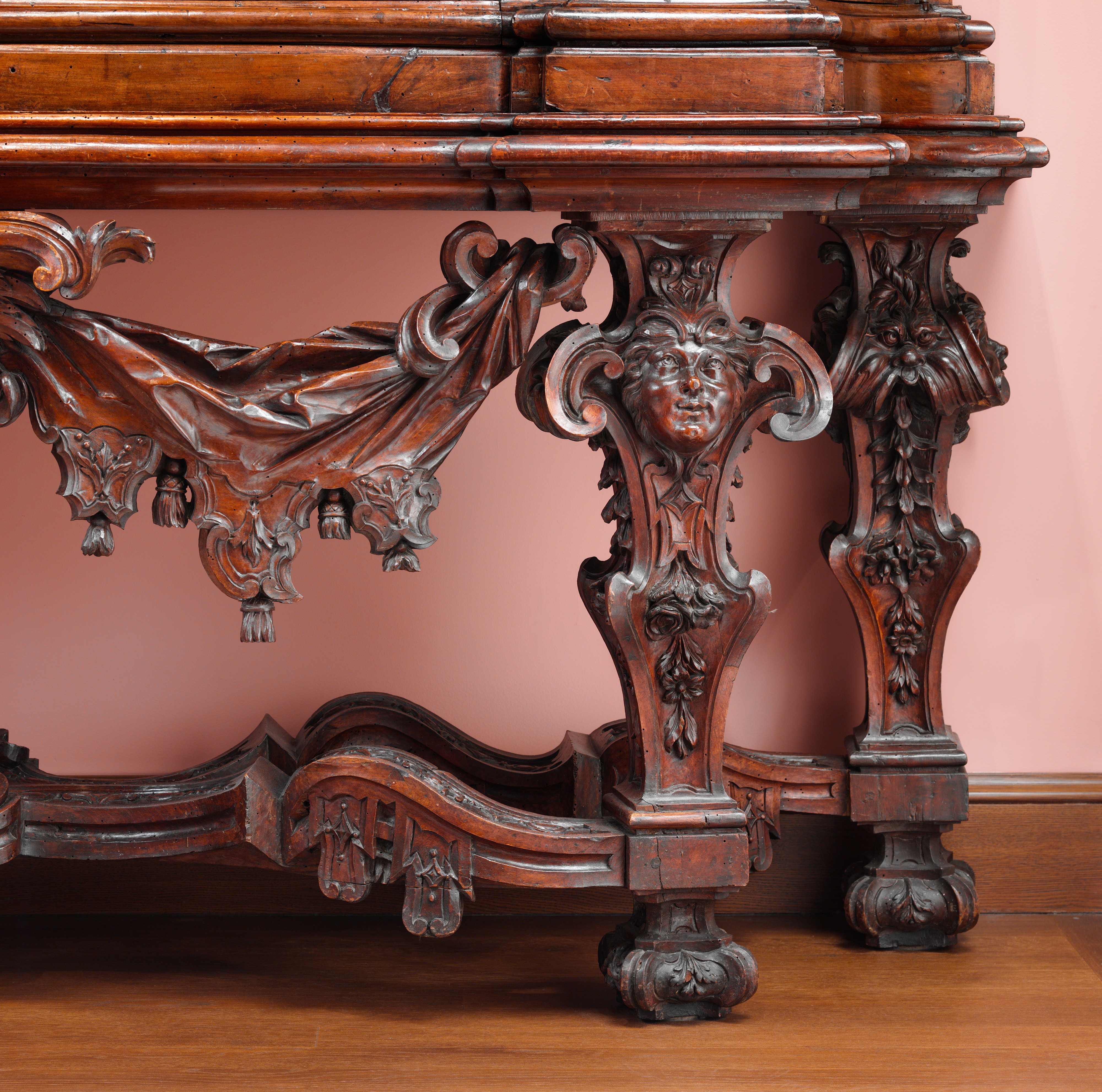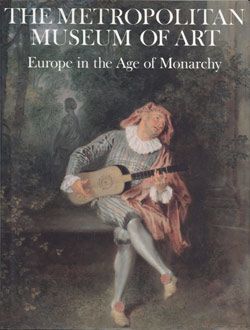Bookcase (one of a pair)
Design attributed to the architect Niccolo Michetti Italian
During the seventeenth and eighteenth centuries Rome was the capital of the Papal States. All the important administrative departments of the Roman Catholic Church were located within its walls. Of these, the Sacred College of Cardinals was the most significant. Only its members could vote in conclave for the next Vicar of Christ, a new pope. To become a part of this powerful body was the ultimate goal of everyone pursuing a career within the hierarchy of the church. The Sacred College and the papal household, the familia pontificia, were dominated by a relatively small group of aristocratic and cardinalitial families. Nonetheless, there was also a steady stream of foreign nobility into Rome eager to gain positions or influence. Many of them lingered for the pleasure of observing the many public spectacles that were part of the display of ecclesiastical power. Spectacle was an integral component of daily life in the Eternal City, and the line between a staged performance and everyday routine was imprecisely defined.
In this milieu, keeping up appearances was of the utmost importance. The design of furniture naturally reflected this. In addition to large console tables with pier mirrors, ostentatiously decorated display cabinets and bookcases were obligatory features of the public rooms of Roman palaces (see also the catalogue entry for acc. no. 1972.73).[1] At the Palazzo Chigi, the library was designed by the painter, sculptor, and architect Gianlorenzo Bernini (1598–1680), and its shelves were built by the famous cabinetmaker Antonio Chiccheri, a specialist in wood-coffered ceilings.[2] Often pieces were ordered in twos or even fours to achieve a perfect symmetry in the stagelike setting of a room.[3] The colossal dimensions of the Museum's pair of bookcases-only one of which is illustrated here-made them a suitable backdrop for the grandest occasions at the Palazzo Rospigliosi, the residence on Rome's Quirinal Hill of a distinguished family with close ties to the Vatican.[4] The bookcases' heavy facades exude a strength and enduring vitality in a way that is unusual for furniture but is often found in the Roman architecture of Francesco Borromini (1599–1667) and his followers. They are an embodiment of the dramatic and vigorous design of the late Baroque and exquisite examples of sculptural furniture carving.[5]
The stands of the cases look much like contemporary console tables.[6] An artistic detail of great refinement is the use of grotesque masks on the aprons and legs. The humorous faces relieve the composition's heaviness, as do the carved draperies and the noble lambrequin motifs, symbolic of worldly and ecclesiastical power. This fringelike ornament, sometimes with a tassel, originated in medieval times as the scarf worn across a knight's helmet. The most prominent example of its use in later times is on the baldachin by Bernini, erected in 1624–33, in Saint Peter's Basilica. That colossal bronze structure was inspired by the canopy used at every papal coronation from the fifteenth century to 1963, when Paul VI ascended the throne of Saint Peter.[7] Here the lambrequin alludes to the elevated status of the Rospigliosi as a papal family and suggests that the lockable cases, which resemble the cabinets for church reliquaries,[8] contain books and manuscripts that are to be cherished and guarded as "relics of knowledge." The heavy broken-volute pediments surmounted by a grand cartouche that once displayed the heraldry of the family are in notable contrast to the stands.[9] The oval frames are shaped like late Baroque marble portrait or heraldic medallions of the type found on Roman tombs or other commemorative structures.[10] The ornamental language has prompted a cautious attribution of the design of the bookcases to Nicola Michetti (1675–1758), who worked as architect for Prince Giovanni Battista Rospigliosi from 1710 onward.[11]
The Rospigliosi bookcases were bought by Lilliana Teruzzi at the sale of Prince Gerolamo Rospigliosi in 1932.[12] She recognized the grandeur of the objects and committed herself to the purchase, despite the fact that her Roman residence was not large enough to accommodate them; when she left Italy in 1939, she sent them to a warehouse in London. They came to the Museum in 1969, eighteen years before Madame Teruzzi's death, largely thanks to the efforts of Museum curator James Parker, who admired her fine collection of Italian Baroque and Rococo furniture and persuaded her that the Metropolitan, which had relatively little in that area, would warmly appreciate her princely gift.[13]
[Wolfram Koeppe 2006]
Footnotes:
I am grateful to the late Princess Elvina Pallavincini and Michelangelo Lupo for their comments and help with this entry.
1. See "Recent Acquisitions: A Selection, 1998–1999." The Metropolitan Museum of Art Bulletin 57, no. 2 (Fall 1999), p. 34 (entry by Wolfram Koeppe). (The table discussed in that entry was acquired with funds from The Isak and Rose Weinman Foundation, which was established by Madame Lilliana Teruzzi, the donor of the present bookcases, in memory of her parents.)
2. Patricia Waddy. Seventeenth-Century Roman Palaces: Use and the Art of the Plan. New York, 1990, p. 56.
3. Joe Friedman and Marella Caracciolo. Inside Rome: Discovering Rome's Classic Interiors. London, 1993, pp. 14-15 (with an illustration of pairs of matching tables in the Galleria Colonna, Rome); see also Stefanie Walker and Frederick Hammond, eds. Life and the Arts in the Baroque Palaces of Rome: Ambiente Barocco. Exh. cat., The Bard Graduate Center for Studies in the Decorative Arts, Design, and Culture, New York, and the Nelson-Atkins Museum of Art, Kansas City. New Haven and London, 1999.
4. The accession number of the pair to the bookcase illustrated here is 69.292.1.
5. Hugh Honour. "The Eighteenth Century: Italy." In World Furniture: An Illustrated History, ed. Helena Hayward, pp. 154–59, New York, 1965, p. 154, fig. 572 (a Roman showcase); see also "Recent Acquisitions: A Selection, 1998–1999." The Metropolitan Museum of Art Bulletin 57, no. 2 (Fall 1999), p. 34 (entry by Wolfram Koeppe).
6. "Recent Acquisitions: A Selection, 1998–1999." The Metropolitan Museum of Art Bulletin 57, no. 2 (Fall 1999), p. 34 (entry by Wolfram Koeppe).
7. Henry Dietrich Fernández. "The Papal Court at Rome, c. 1450–1700." In The Princely Courts of Europe: Ritual, Politics and Culture under the Ancien Régime, 1500–1750, ed. John Adamson, pp. 141–63. London, 1999, p. 152; and Wilifried Rogasch. Adel. Dumont-Taschenbücher 548. Cologne, 2004, p. 176. For the lambrequin motif, see Maurizio Fagiolo dell'Arco, ed. The Art of the Popes from the Vatican Collection: How Pontiffs, Architects, Painters, and Sculptors Created the Vatican. Milan, 1983, p. 139 (lower ill.); Heinrich Kreisel. Die Kunst des deutschen Möbels: Möbel und Vertäfelungen des deutschn Sprachraums von den Anfängen bis zum Jugendstil. Vol. 2, Spätbarock und Rokoko. 2nd ed. Rev. by Georg Himmelheber. Munich, 1983, fig. 391; Wolfram Koeppe. "Ein Girandolenpaar des Albrecht Biller: Addenda zum Einfluss französischer Ornamentformen auf die Augsburger Goldschmiedekunst um 1700." Jahrbuch des Museums für Kunst und Gewerbe Hamburg, n.s., 8 (1989; pub. 1991), p. 70 and n. 20, figs. 1, 7, 13; and Der Glanz der Farnese: Kunst und Sammelleidenschaft in der Renaissance. Exh. cat., Palazzo Ducale di Colorno, Parma; Haus der Kunst, Munich; and Galleria Nazionale di Capodimonte, Naples. Munich, 1995, p. 32, fig. 12.
8. Wolfram Koeppe and Michelangelo Lupo. "Lo Heiltumsaltar nella sacrestia della cattedrale di Trento." In Ori e argenti dei santi: Il tesoro del Duomo di Trento, ed. Enrico Castelnuovo, pp. 35–56. Storia dell'arte e della cultura. Trent, 1991; and Anna Maria Spiazzi. "Gli armadi delle reliquie nella cappella del tesoro." In Basilica del Santo: Le oreficerie, ed. Marco Collareta, Giordana Mariani Canova, and Anna Maria Spiazzi, pp. 15–26. Padua and Rome, 1995.
9. The panels presently in the cartouches (but hardly visible in the photographs in this book) are modern reproductions after historical photographs of the almost illegible painted inserts.
10. J. Paul Getty Museum. Masterpieces of the J. Paul Getty Museum: European Sculpture. Los Angeles, 1998, p. 81, no. 27 (entry by Marietta Cambareri and Peter Fusco).
11. The Metropolitan Museum of Art. The Metropolitan Museum of Art: Notable Acquisitions, 1965–1975. New York, 1975, p. 256 (entry by Penelope Hunter-Stiebel); Patterns of Collecting: Selected Acquisitions, 1965–1975. Exh. cat., The Metropolitan Museum of Art. New York, 1975, p. 40; and James Parker. "A Pair of Bookcases on Stands from the Palazzo Rospigliosi." In Studien zum europäischen Kunsthandwerk: Festschrift Yvonne Hackenbroch, ed. Jörg Rasmussen, pp. 229–37. Munich, 1983, pp. 229-37, figs. 2-8.
12. Sale, Palazzo Rospigliosi, Rome, 12-24 December 1932.
13. James David Draper. "A Life at the Met: James Parker and the Collecting of Italian Furniture." Apollo 139 (January 1994), p. 21.
This image cannot be enlarged, viewed at full screen, or downloaded.
This artwork is meant to be viewed from right to left. Scroll left to view more.






